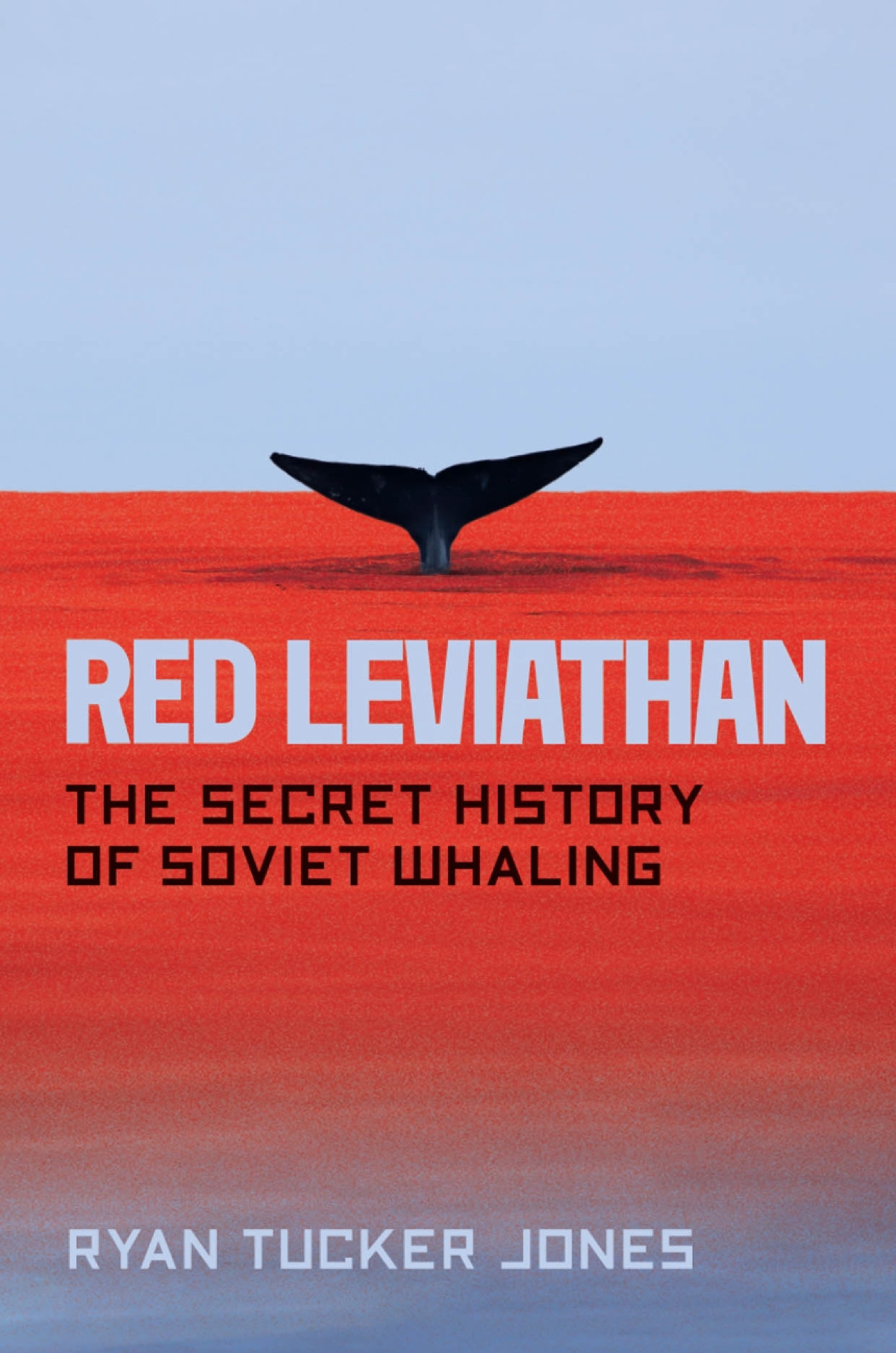When Moby Dick smashes his head into Captain Ahab’s ship, concluding Herman Melville’s timeless classic, the ship, along with its crew, is sunk to the bottom of the ocean. The destruction, wrought in self-defence by the monstruous whale, becomes a sign of the terrible consequences of the human pursuit of power and dominance.
When the Soviet whalers took to the seas, harpooning their first cetacean on Oct. 25, 1932, the fifteenth anniversary of the Bolshevik Revolution, there was no such resistance from the whale. The environmental toll to be wrought over the next half a century, however, would be greater than Melville could ever have imagined.
In his book, “Red Leviathan: The Secret History of Soviet Whaling,” shortlisted for the 2023 Pushkin House Book Prize, Ryan Tucker Jones explores the hitherto untold story of Soviet whaling, which, over the course of the twentieth century, resulted in the slaughter of more than half a million of the planet’s largest animals. Jones, a professor of history at the University of Oregon, explores how this profitable industry was driven by far more than mere commercial considerations, but by pride, competition and a deep-rooted sense of historical injustice.
In the 19th century, Russia lagged far behind on the whaling front. Instead, it was America who ploughed the seas off the coast of Siberia. In response, Russian and eventually Soviet officials made arguments to the international community for the conservation of whales and the protection of indigenous hunting grounds. At the time, Jones reminds us, many Siberian natives relied on these nutritious mammals for subsistence.
But in the 1950s, the tables were turning and the U.S.S.R., spurred on by envy of other nations like Japan and Norway who had already cemented themselves as some of the most profitable whaling powers, adopted duplicitous tactics. Soviet whalers would arrive in the Antarctic weeks, even months before the official hunting season began and would stay for some time after in order to make up for years of lost ground.
The Soviets further increased their catches by making use of science and statistics to reveal whale locations and migration patterns. It was this science that led the Soviet whalers to their greatest successes, turning whaling into a symbolic triumph of socialism over nature. In spite of storms, mechanical faults and elusive prey, their catches consistently surpassed expectations. Despite all the odds, the workers, as a collective, succeeded. The well-paid whalers, who were celebrated in the same vein as movie stars and whose stories became etched into literature and films, were its pride and joy.
At the same time, Soviet scientists made some of the most revolutionary breakthroughs in understanding whale history and behaviour. The Soviets recognised whales as intelligent beings capable of feeling pain and exhibiting emotions. They discovered that these impressive mammals could even communicate through a system of clicks, whistles and pulsed calls.
However, the dire warnings from Soviet scientists about the environmental and economic consequences of excessive whaling went unheeded. Jones depicts the gruesome reality of whalers firing their harpoons, puncturing the lungs of the fleeing cetaceans and causing blood to fountain out of their blowholes – a spectacle Soviet whalers mockingly referred to as the “red spout.” The dead whales would then be hauled aboard, and the blue water of the ocean would turn a bloody red.
The thrilling climax of “Red Leviathan” comes in the famous confrontation between Soviet whalers and Greenpeace protestors forty-miles South of the Californian coast in 1975. It was the culmination of the tens of thousands of slaughtered whales that had gone unreported by the Soviets to the International Whaling Commission. The reader sees the confrontation, for the first time, from the Russian perspective as Jones reveals the shock of the Russian whalers who clapped along as protestors began to chant and sing, as well as the silence from Moscow in the months and years that followed.
Soviet whaling officially ended in 1987 but its story is only just being told today. “Red Leviathan” is a moral story that is neither accusatory nor forgiving, but which reveals how Soviet hopes that communism would forge a better relationship with the natural world were thoroughly disappointed.
Red Leviathan: The Secret History of Soviet Whaling

From Chapter 8: The Cetacean Genocide
[The] whalers themselves rarely ever spoke or wrote about the conquest of nature, even as they devoted many pages to the conquest of poor discipline and drunkenness. It is almost as if the conquest of nature, and of whales, was so complete by the 1960s that there was little point in talking about it. Whales are everywhere in the onboard newspapers, but mostly as units of production, as inert as coal or steel, as divisible and unremarkable as sticks of margarine. Never do they appear as adversaries.
It may seem counterintuitive, but I think that alongside other, darker motivations, Soviet whalers’ fascination with whale fetuses and lactation—parts of whales that still seemed alive, even after death—expressed a deeper desire to recover the vitality of their prey. It expressed a desire to move beyond the idea of whales as a numbing series of numbers, beyond the scientists’ insistence that whales were not mysterious, beyond the natural world as an undifferentiated conquest. All these conceptions ultimately stole from the whales what the whalers knew to be true of them. They also took from the whalers what they most wanted: a profession and kollektiv full of real, unpredictable life, not just the regimentation of ritual and plan. If the means they found to express such desires were perverse, that reflects the ultimately irreconcilable contradictions of life on board the industrial, socialist whaleship plunged into the modern oceans of death.
If in some ways Soviet whalers recoiled at this mass slaughter, for many species of whales, the loss was crushing. In the worst cases, it meant near-complete extinction. As the biologist George Small wrote in 1971, from the deepest depths of blue whales’ history: “Today the blue-whale population probably numbers something between 0 and 200 individuals. . . . What, then, are the chances for the survival of the blue whale? None.” Soviet scientists on board the Antarctic fleet that same year were writing that “if reported violations are not stopped, it will be a straightforward explanation for the extinction of the largest animal on the planet and thus will be one of the greatest crimes of mankind.” These predictions of extinction were wrong, but not by much. Blue whales in the Antarctic remain at less than 1 percent of pre-whaling abundance, a number that must have been ever lower in the 1970s. South Pacific humpbacks are thought to have declined from around 27,000 individuals to only 450. Southern right whales, which had been driven nearly to extinction in the nineteenth century and were illegally hunted by the Soviets in the twentieth, may have reached similarly low levels. Fin whales likely survived in somewhat larger numbers, but still were reduced by at least 75 percent around the globe. Sei whales in the North Pacific probably declined from about 42,000 to 8,600 individuals, with an even greater reduction in the Antarctic. Some local populations of sperm whales were nearly totally annihilated, though on the whole, the species did better than others, as did minke whales. By the 1970s, the oceans were eerily empty places. Once-abundant whale communities persisted only in pockets. While some species, like gray whales, were beginning to rebound, others, like blues and South Pacific humpbacks, were ghosts, their rare appearances a startling reminder of a plenteous world already passing from memory.
Large whales had become an insignificant part of the ecosystems they had dominated for millennia, and we are still grappling with the consequences of their removal. There is very little baseline data to work with, so it is hard to estimate the impact. But a few things are clear. First, though many at the time thought the loss of whales would free up lots of extra krill for other animals to eat, this is not true, at least not in the long run. The reason for this is whale excrement. Whales defecate malodorous but nutritious streams of pinkish liquid that is particularly rich in iron taken from krill exoskeletons. Iron is rare in the oceans, especially in the upper water column, and thus the whale excrement is quickly taken up by phytoplankton, which feed krill and stimulate further production. When humans decimated whale populations, especially in the Antarctic, they also removed rare iron from the ecosystem. Every other creature on the food chain has suffered, and so the loss of whales was a loss for entire polar communities.
Other oceanic species probably did benefit from the loss of whales. Large squid, for example, likely proliferated, given the roughly 60 percent decline in one of their main predators, sperm whales. But the well-known explosion in squid numbers over the last several decades has revealed one of whales’ most important functions in oceanic ecosystems: stability. Long lived and wide ranging, whales even out prey populations around the ocean and carry with them reserves of energy accumulated over many years. They act, in a sense, as ecological “memory,” storing up the energy of abundant years so that ecosystems emerge relatively unaltered from lean ones. Short-lived, rapidly reproducing squid populations, on the other hand, boom and bust with climate and other factors, and so a mass death can produce huge fluctuations, and potentially permanent changes, to the ecosystems around them.
Whaling’s history reverberates in another way as well. Mammal-eating killer whales, mostly bereft of large prey, had to search for other prey. The point is controversial among scientists, but some believe these killer whales turned to the far less nutritive minke whales, elephant seals, sea lions, fur seals, and even very small sea otters. The impact on these species was devastating in its own right. By the 1990s, all were in decline, in some cases catastrophically, their deaths possibly an echo of whale deaths and human excesses from decades earlier.
What must industrial whaling have felt like to whales? This requires speculation, but we do have some idea. Whales have both very sensitive skin and the long memories necessary to find their way repeatedly across half the planet along migration routes, so pain and its memory would have been prominent parts of whales’ lives in the twentieth century. Remarkably, an excellent proxy for these emotions exists in the form of the layers of wax deposited every year in a whale’s internal ear canals. The wax preserves stress hormones, such as cortisol, that coursed through the whale’s body when it experienced fear or pain. Because whale scientists collected these earplugs throughout the whaling years, scientists have been able to assemble a data set of historical whale emotions. What they show is not surprising: stress levels of whales jumped in the 1930s, fell during the war years of the 1940s, and then rose dramatically until about 1963, the peak year of postwar whaling. As the earplugs measure the stress of animals that survived years of hunting before finally being killed, they likely indicate that a whale’s anguish resulted as much from the death of its companions as from being chased itself. Indeed, those whales that were chased were very unlikely to have survived long enough to accumulate earplugs with any time depth.
Within this composite suffering, there must have been particularly agonizing moments. One must have come when calf, mother, or companion were killed. Another, though, must have come later. Those whales who survived the polar slaughter and returned to their breeding grounds faced a terrible problem: the essential components of social life were gone. Most imperative, this meant they might not find any mates—the whole reason for their migration there. A humpback whale migrating past New Zealand might end up at its birth lagoon in Tonga and find itself alone, or with only a few companions. Perhaps those left were all females, or a few males and one female. If each individual whale likely experienced the killing in the Antarctic as a local, singular event, the breeding grounds revealed the scale of the slaughter. This must have been the moment, if any, when the whales realized what had happened to their societies. We can at least guess that they did realize it in some way: records over subsequent decades suggest that humpback whales abandoned some breeding grounds—Fiji, for example—in favor of other places where more of their own could kind be found, such as Eastern Australia. Alone in a lagoon, having seen and heard the last moments of their families and companions, those still left ventured out into the unknown, across empty ocean, until they heard again the familiar songs, low and mournful, drawing them toward new lives and the survival of their kind.
Reprinted with permission from "Red Leviathan: The Secret History of Soviet Whaling" by Ryan Tucker Jones, published by The University of Chicago Press. © 2022 by Ryan Tucker Jones. All rights reserved. For more information about the book and author, see the publisher's site here.
Red Leviathan: "The Secret History of Soviet Whaling" has been shortlisted for this year’s Pushkin House Book Prize, which will be awarded on June 15 in London. Tickets for the ceremony are available here.
A Message from The Moscow Times:
Dear readers,
We are facing unprecedented challenges. Russia's Prosecutor General's Office has designated The Moscow Times as an "undesirable" organization, criminalizing our work and putting our staff at risk of prosecution. This follows our earlier unjust labeling as a "foreign agent."
These actions are direct attempts to silence independent journalism in Russia. The authorities claim our work "discredits the decisions of the Russian leadership." We see things differently: we strive to provide accurate, unbiased reporting on Russia.
We, the journalists of The Moscow Times, refuse to be silenced. But to continue our work, we need your help.
Your support, no matter how small, makes a world of difference. If you can, please support us monthly starting from just $2. It's quick to set up, and every contribution makes a significant impact.
By supporting The Moscow Times, you're defending open, independent journalism in the face of repression. Thank you for standing with us.
Remind me later.







